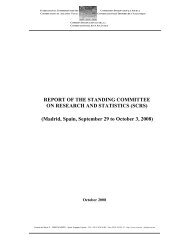E - Iccat
E - Iccat
E - Iccat
Create successful ePaper yourself
Turn your PDF publications into a flip-book with our unique Google optimized e-Paper software.
ICCAT REPORT 2012-2013 (I)<br />
126<br />
1) Modifying how the quorum is calculated for an inter-sessional vote;<br />
2) Providing additional steps throughout the process to remind members of the requirement to respond to an<br />
inter-sessional vote, and;<br />
3) Not considering a failure to respond to an inter-sessional vote as an indication that a member is abstaining<br />
from voting.<br />
1) Modifying how the quorum is calculated for an inter-sessional vote<br />
The ICCAT Convention provides, in article III (3):<br />
Except as may otherwise be provided in this Convention, decisions of the Commission shall be taken by a<br />
majority of the Contracting Parties, each Contracting Party having one vote. Two-thirds of the Contracting<br />
Parties shall constitute a quorum.<br />
At a meeting of the Commission, the quorum is defined as the minimum number of members that must be<br />
present for a decision to be taken. Hence, the criterion for the quorum is merely that the members be present, not<br />
that they vote. Nevertheless, in practice, the members present will usually vote or register an abstention when a<br />
vote is called, rather than refrain from participating in a vote. Consequently the quorum will be representative of<br />
the number of members participating in a decision on a proposal put to a vote.<br />
In the case of inter-sessional votes, paragraphs 12 and 15 of Rule 9 of the Rules of Procedure currently provide<br />
that the members that have confirmed their reception of a proposal or request put to an inter-sessional vote be<br />
considered for the purpose of a quorum. As a result the quorum can differ significantly from the number of<br />
members who respond to the Executive Secretary indicating whether they cast votes or abstain from voting.<br />
It is proposed to modify paragraphs 12 and 15 of Rule 9 of the Rules of Procedure so that for the purpose of an<br />
inter-sessional vote, the quorum should only include responses received from members, indicating whether they<br />
cast an affirmative vote, cast a negative vote or abstain from voting. Ultimately, if less than two thirds of the<br />
members respond to an inter-sessional vote, there would be no quorum and no decision would be taken.<br />
2) Providing additional steps throughout the process to remind members of the requirement to respond to an<br />
inter-sessional vote<br />
Under paragraph 14 of Rule 9 of the Rules of Procedure, members have 40 days to respond to an intersessional<br />
vote, either with an affirmative vote, a negative vote, an indication of their abstention or a request for additional<br />
time for voting, in which case a further 30 days shall be allowed from the expiration of the initial 40-day period.<br />
In the event of an extension, the Executive Secretary has to inform all members of the final date by which<br />
responses must be received. Aside from this information, the Executive Secretary is not required to communicate<br />
with the members during the 40 or 70-day voting period.<br />
To encourage members to respect the requirement to respond to an inter-sessional vote, it is proposed that Rule 9<br />
be modified to require additional communications by the Executive Secretary to the members at various stages<br />
of the process:<br />
• In paragraph 13 of Rule 9, if no request for an inter-sessional vote on the chairman’s determination has<br />
been received after 10 days, the Executive Secretary informs the members and reminds them of the<br />
number of days left to respond to the initial proposal.<br />
• 10 days before the end of the initial voting period, if no request for an extension of time has been<br />
received, the Executive Secretary informs the members of the approaching expiration of the 40-day<br />
period, reminds them of the requirement to respond and could identify the members whose responses<br />
have not yet been received.<br />
• In paragraph 14 of Rule 9, the Executive Secretary when informing the members of the final date by<br />
which responses must be received after an extension could identify the members whose responses have<br />
not yet been received.<br />
3) Not considering a failure to respond to an intersessional vote as an indication that a member is abstaining<br />
from voting<br />
Under paragraph 15 of Rule 9 of the Rules of Procedure, if no reply from a member is received within 40 days of<br />
transmittal, or by the extended deadline specified by the Executive Secretary in the event of a 30-day extension<br />
to consider the proposal, that member shall be recorded as having abstained.

















